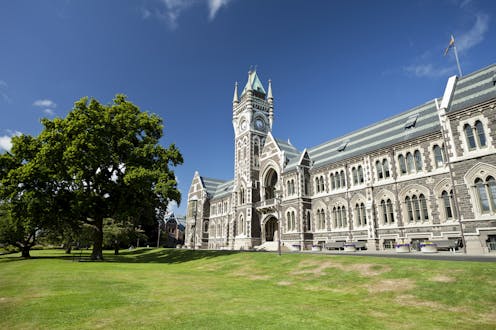
Yesterday’s announcement of NZ$128 million in new funding for universities has naturally been welcomed as a badly-needed reprieve. But we have to ask, is this a bailout for struggling institutions, or is it just a Band-Aid on a tertiary sector with deeper structural wounds?
It’s clear the pandemic massively exacerbated the challenges caused by years of funding below inflation rates. All universities have seen previous redundancy rounds, some of which may have been inevitable.
But whatever academic fat there was to lose is gone. Recent cuts have bitten into flesh, and now the bone saws are out. The choices being made about which teaching programmes should go – teacher training, modern languages or geophysics – are no choice at all, other than which limb to amputate.
So the government’s simultaneous proposal to review the tertiary funding model offers a chance to take the system back to basics – to remind us why these institutions are publicly funded in the first place, and to give them a warrant of fitness for the 21st century.
The ‘per student’ funding problem
The proposal to spread the $128 million (over two years) across all tertiary institutes – universities, wānanga and Te Pukenga – looks fair and consistent. As such, it looks far less like a bailout of particular institutions than an admission that the current policy settings are not fit for purpose.
But that fairness also reveals the problem with our funding settings. Tertiary education subsidies are allocated “per student”, and this structurally advantages larger institutions.
There is a baseline cost of operating a teaching programme or department, on top of which additional students cost relatively little. We fund research in universities in this way, through baseline funding topped up by contestable grants, but not teaching.
Read more: Starved of funds and vision, struggling universities put NZ’s entire research strategy at risk
The University of Auckland, for example, is currently in an enviable financial position, by local standards at least. Yet it will pick up more new funding than any other university by virtue of having the most students.
Furthermore, the new funding won’t avert all the proposed redundancies. The downside of “fairness” is that the funding holes at Victoria and Otago universities will not be covered. It will likely be the same story at AUT, Massey and Waikato.
So yes, the $128 million is perhaps just a Band-Aid. But it does buy time to rethink and re-strategise while the system is reviewed – which was the most important part of yesterday’s announcement.
University leadership accountability is now under the microscope – under many microscopes, even. Any redundancies with strategic implications for what a university can teach or research should now be delayed as much as possible.
Value and equity
First and foremost, the New Zealand public owns and operates tertiary education institutions because they deliver economic and social value: value for the student who learns and acquires a qualification; and value for those who don’t attend but will rely on those who do (such as doctors and nurses).
There is a question of equity, too. Some New Zealanders might be able to pay for their children to study overseas, but equal access to education at home should be a fundamental principle.
All this becomes important when we ask what our university system should look like. For example, do we need eight universities competing for both students and funding?
I don’t think there is an easy answer to that. The University of Auckland has long had a strategy of leveraging its size to claim the position (and reputational advantages) of being New Zealand’s “highest-ranked” university internationally.
The smaller universities, by contrast, have been strategic about facing their local communities more directly, and building reputations in specific fields. We should therefore not be cavalier about downsizing the sector in general. The benefits of a university to a community should be widely distributed.
Minister of Finance Grant Robertson touched on this at the funding announcement when he said universities had perhaps spent too much on marketing. And that may be true of their efforts to maximise international rankings to maximise international student revenue.
But the fact that each university has its own identity, developed over many years in collaboration with its local community, is also something to celebrate.
3 important questions
Overall, then, yesterday’s announcement offers hope because it recognises the need for coordination between universities on teaching – with a report to Cabinet in a month on the risks to specific programmes – and because it acknowledges the immediate threat to New Zealand’s national research capacity.
The two-year time frame for the review of funding structures is probably realistic, given the complexity of current funding models. The interdependence of research and teaching income streams needs to be examined carefully.
The different sizes of institutions, and different levels of research and teaching focus, mean seemingly simple models can have unanticipated biases, whether towards certain (larger or more research-intensive) institutions, or towards particular types of scholarship (such as science over the humanities).
The anticipated outcomes of any proposed new model will need to be measured against the Education Act’s definition of a university and its reasons to exist:
does it maintain a balance (and interdependence) of teaching and research?
does it maintain a diversity of scholarship, the sciences and the arts, the quantitative and the qualitative?
and does it deliver for its community, and thus justify its independent existence?
Academic freedom is enshrined in the law as meaning universities operate as the “critic and conscience” of society. But their responsibility to community is a useful way of thinking about what that means, in my opinion. Either way, these seem like the necessary questions to ask if we want to get back to basics.
Nicola Gaston receives funding from the Tertiary Education Commission as Co-Director of the MacDiarmid Institute, and from the Royal Society Te Aparangi as an Investigator on Marsden research grants.
This article was originally published on The Conversation. Read the original article.







